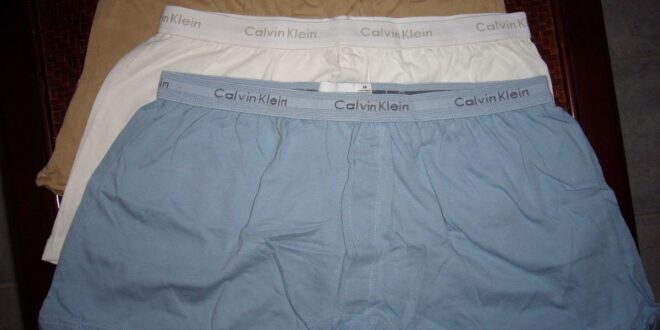Underwear can be a divisive subject. Most men swear by their choice, be it their tidy whities, boxers, briefs, or boxer briefs. Yet many people still fail to differentiate between boxers and briefs. So what is the difference between boxers and briefs?
Generally, briefs do not cover the thighs, unlike boxers. Briefs are tighter, while boxers are looser. Briefs may offer better sweat absorption on the crotch, while boxers may not. Some may prefer the snug and better support briefs, while others prefer the loose, hanging, and airy feeling boxers offer.
This article explores the differences between boxers and briefs. We start by looking at boxers and briefs and then at how they differ.
We also explore common questions about boxers and briefs, such as which ones are more popular and how tight these underwear should be.
What Are Boxers?
Boxers are a type of loose underwear worn by men. It covers the thighs and allows unhindered movement; the name came from their similarity to the shorts boxers wear when fighting and training. Boxers tend to be made from cotton or cotton blends, although you can also see boxers made with satin or silk.
Boxers are simply an undergarment worn by men. It gets its name from the shorts that boxers wear, which are loose and do not hinder movements. Most modern boxers retain a similar original design with minor changes.
Common boxer shorts are usually made with cotton or a blend of cotton and polyester for better comfort. You may also see boxers made with satin, silk, or jersey knits.
Most boxer shorts have a fly made upfront. The mechanism to close the fly may depend on the design of the underwear maker. Buttons are popular, although you may also see riveted metal snaps.
You may also see boxers designed to have the fly overlapping each other. This means there is no need to close them. This is mainly referred to as open-fly design and is also used on tight boxers.
Boxers are rarely made with elastic material compared to other men’s underwear. This means boxers tend to have a more generous fitting on the fabric, to accommodate body movements, especially when the wearer bends forward. Many commonly refer to this as the ‘balloon seat.’
Boxer shorts are usually available in white and many other solid colors. More modern boxers are also made with more variety in patterns and prints. Common patterns include checkers, plaids, and vertical stripes. Less conventional designs may contain patterns, messages, or even pictures.
What Are Briefs?
Briefs are a style of form-fitting underwear popular with both men and women; they usually have an elastic waistband and material covering the pelvis, crotch, and buttocks. They are preferred by men who engage in sports or active activities, as it provides better support and cradling for the genitalia.
Briefs are a style of underwear that is short and form-fitting. It differs from boxers because the material does not extend down the thighs. Briefs usually have an elastic waistband and material covering the pelvis, crotch, and buttocks.
Briefs are a very common style of underwear and have versions for females; they are also made into swimwear for both men and women.
The first briefs were sold in 1935 in the US and were given the name ‘Jockey’ since they offered a similar level of support as the jockstrap briefs. When it was introduced, it was so popular that 30,000 pairs were sold within three months.
Briefs’ popularity peaked in 1990 when it was reported that up to 50% of the underwear sold to men were white briefs. However, briefs became less popular in the 2000s as boxer shorts and tight boxers became popular again.
Active promotions from brands such as Calvin Klein’s tight boxers also further lowered briefs’ popularity.
READ MORE: Is Calvin Klein A Good Brand?
Similar to boxers, briefs also have a fly-up front. However, most briefs were made in the open-fly design, which means there are no buttons on the briefs. This may be because briefs are form-fitting, and putting a button may be uncomfortable.
Briefs are also form-fitting, which means they provide stronger support and cradling of the genitalia. As a result, briefs become popular with men who are participating in sports or anything active. Briefs are also popular with many men as it does not ride up the thighs, unlike boxers or tight boxers, making them uncomfortable.
How Do Boxers And Briefs Differ?
Boxers and briefs differ in many areas, such as coverage, tightness, support, visible lines, use, breathability, and popularity. These differences eventually resulted in men having a preference for one over the other.
| Aspects | Boxers | Briefs |
| Coverage | Similar to briefs, but extends to thighs | Pelvic, buttock, groin, genitalia |
| Tightness | loose | tight |
| Support | Little to no support | Good support |
| Visible Lines | No visible line under trousers | May show visible line under trousers |
| Use | Underwear, shorts at home | Underwear only |
| Breathability | Airy and very breathable | Not very breathable |
| Popularity | Most popular underwear | Less popular |
| Fly | Mixture | Open fly |
Generally, both boxers and briefs are undergarments and can come in multiple colors, motives, and designs. However, the similarities probably end here. Boxes and briefs are very different in many ways from each other.
Coverage
Boxers cover more areas of the skin compared to briefs. Briefs cover the waist, pelvic region, buttocks, groin, and genitalia. Boxers also cover all the areas and add the inner and outer thighs to the list.
Tightness
Boxers are loose, while briefs are tight. Loose underwear allows better breathability and, in some ways, better movement range. However, tighter underwear may be preferred by those who wear more form-fitting clothes, as it prevents the boxers from making their clothes look baggy.
Support
Boxers do not support the genitalia but to let it hang free. Briefs are tighter, which provides support and cradling to the genitalia. These made briefs preferred by those who engage in active activities, such as sports.
Fly
Boxers may come in multiple types of fly. Some have traditional buttons, while some have metal or plastic snap-on to secure the fly. Modern boxers may also come with an open fly, where the fly sides are made to overlap each other. Briefs almost exclusively have only open fly, as buttons on tight briefs may be uncomfortable.
Visible Lines
When worn under tighter or form-fitting trousers, briefs may show lines, particularly on the buttock area. This does not happen if you wear boxers.
Breathability
Boxers are generally breathable, as it is loose and does not adhere to the skin. This allows moisture to escape easily, making it comfortable. Briefs are tighter, meaning it is not as breathable. Moisture also may be trapped easily inside.
Use
Boxers may work as underwear or as shorts while at home. Its loose fitting and skin coverage made it more acceptable to be seen wearing one. Briefs tend to be worn as underwear, and that is pretty much it. Briefs may be ok on the beach or swimming pool, but not the underwear type, but swimming trunks.
Popularity
US men are known to prefer boxers over briefs. 50% of US men wear boxers, and the other 50% wear briefs, boxer briefs, or another type of underwear.
Do More Guys Wear Boxers?
Boxers remain the most popular underwear for men in the US, with over 50% wearing them. The other 50% wear either briefs, boxer briefs, bikinis, or other tight-fitting underwear. The popularity may be explained by its comfort level and the general realization that tight underwear may not be good for sperm production.
The New Yorker reported that 50% of men in the US wear boxers, while the other 50% wear either brief, boxer briefs, bikinis, or other forms of tight-fitting underwear. This may come as a surprise since boxers may be associated with older men and may not look well with tailored, form-fitting clothes most men wear today.
Perhaps such preference could be explained by the level of comfort boxers bring. Boxers are loose-fitting, meaning they allow full movements while at the same time being airy. Airiness may help to remove moisture from the crotch, making boxers more comfortable.
Tighter underwear, such as briefs or boxer briefs, may also offer similar levels of mobility. Still, they are more likely to trap moisture since they are tight. On top of that, boxers could also be worn as casual shorts at home, meaning they may be more flexible.
There is also the realization that tighter underwear may not be good for men, as it prevents the natural sagging of the testes. Testes naturally sag slightly out from the body. The testes must be several degrees below the human body temperature to produce testosterone at a good level.
Boxers do not prohibit this, which may be better for men’s sperm and testosterone production. As a result, more men switched to wearing boxers.
How Tight Should Briefs Be?
Briefs should be tight enough to provide support but not too tight that it becomes uncomfortable or leave imprints on the skin. It should support and cradle the genitalia, but not to the point it feels uncomfortable or hot. Consider cooling and skin-friendly materials such as cotton, cotton blends, or Spandex.
Generally, when it comes to briefs, it may be harder to decide if they fit well, as you cannot test wearing briefs like other pieces of clothing. Some brief makers also do not do returns.
However, one good thing is that briefs are not too expensive, which means if you buy one that doesn’t fit, you can always get new ones.
The best briefs are the most comfortable briefs. This means they should be tight to provide a ‘supported and cradled’ feel but not to the point that it feels too snug to leave imprints.
The tightness may be felt most at the waistband, especially if you have purchased an undersized brief. The band may feel too tight if you feel uncomfortable, and when you take it off, you see imprints on your skin.
Other areas are the genitalia and the crotch. They should feel cradled by the brief, not pressed into a mold by it. It may feel uncomfortable when the brief is too tight on these areas.
Secondly, moisture cannot escape your crotch and genitalia when it is too tight. This means these areas may get too moist and feel sweaty and uncomfortable. The excess moisture also may cause you to feel itchy as well.
For added comfort, consider more flexible fabric materials that provide adequate support and snug feel while allowing maximum movement and breathability. Spandex is a good choice, as well as polyester blends.
 Being Human
Being Human




